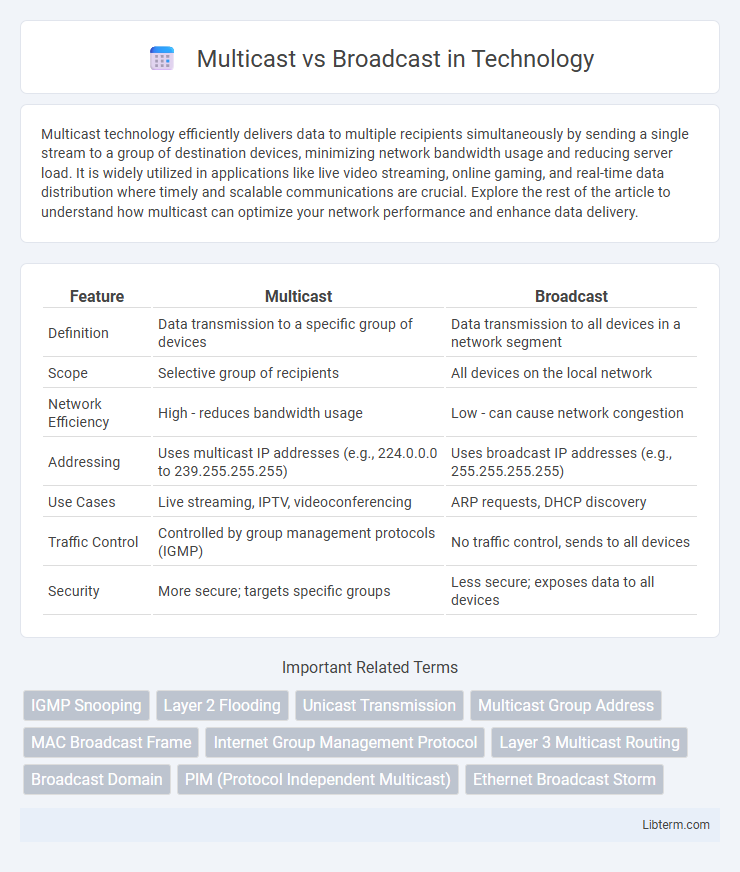Multicast technology efficiently delivers data to multiple recipients simultaneously by sending a single stream to a group of destination devices, minimizing network bandwidth usage and reducing server load. It is widely utilized in applications like live video streaming, online gaming, and real-time data distribution where timely and scalable communications are crucial. Explore the rest of the article to understand how multicast can optimize your network performance and enhance data delivery.
Table of Comparison
| Feature | Multicast | Broadcast |
|---|---|---|
| Definition | Data transmission to a specific group of devices | Data transmission to all devices in a network segment |
| Scope | Selective group of recipients | All devices on the local network |
| Network Efficiency | High - reduces bandwidth usage | Low - can cause network congestion |
| Addressing | Uses multicast IP addresses (e.g., 224.0.0.0 to 239.255.255.255) | Uses broadcast IP addresses (e.g., 255.255.255.255) |
| Use Cases | Live streaming, IPTV, videoconferencing | ARP requests, DHCP discovery |
| Traffic Control | Controlled by group management protocols (IGMP) | No traffic control, sends to all devices |
| Security | More secure; targets specific groups | Less secure; exposes data to all devices |
Understanding Multicast and Broadcast
Multicast delivers data packets to a specific group of destination devices, optimizing network bandwidth by limiting traffic to only those interested in the content. Broadcast sends data packets to all devices on a network segment, regardless of whether they need the information, often causing unnecessary network congestion. Understanding the distinction between multicast and broadcast is crucial for efficient network design and minimizing resource consumption.
Key Differences Between Multicast and Broadcast
Multicast delivers data to a specific group of receivers identified by a single multicast IP address, optimizing network bandwidth by sending one copy of the data to multiple recipients. Broadcast transmits data to all devices within a network segment using a broadcast address, potentially leading to network congestion due to unnecessary data delivery. Multicast requires receiver subscription and is scalable for large networks, whereas broadcast impacts all nodes regardless of interest, making it less efficient for targeted communication.
How Multicast Works in Networking
Multicast in networking efficiently delivers data to multiple recipients by sending a single stream of information only once over each network segment, utilizing multicast IP addresses within the range 224.0.0.0 to 239.255.255.255. Routers employ protocols like Internet Group Management Protocol (IGMP) to manage group memberships and Protocol Independent Multicast (PIM) to build optimal distribution trees, ensuring data replication occurs only at necessary branching points. This method reduces bandwidth usage compared to broadcast, which sends data to all nodes in a subnet regardless of their interest, optimizing network resource utilization.
How Broadcast Functions in Data Transmission
Broadcast transmits data simultaneously to all devices within a network segment by sending packets to the broadcast address, ensuring every node receives the message regardless of its need. This method leads to higher network traffic and potential congestion as all devices process the broadcast frames, even if only one requires the data. Broadcast is essential in tasks like ARP (Address Resolution Protocol) where devices need to discover hardware addresses within a local network.
Advantages of Using Multicast
Multicast enables efficient data distribution by sending information only to a specific group of interested receivers, significantly reducing bandwidth consumption compared to broadcast, which transmits packets to all devices regardless of relevance. This targeted approach minimizes network congestion, enhances scalability for streaming applications like IPTV and video conferencing, and optimizes resource utilization in large-scale deployments. Multicast's ability to improve network performance and reduce unnecessary load is essential for delivering high-quality, real-time content to multiple endpoints simultaneously.
Drawbacks of Multicast Communication
Multicast communication faces challenges such as limited support across routers, leading to inconsistent delivery and network segmentation issues. It requires complex configuration and management, increasing operational overhead and the risk of misconfigurations. Scalability can be hindered by protocol limitations and dependency on group membership tracking, potentially causing inefficiencies in large or dynamic networks.
Benefits and Limitations of Broadcast
Broadcast communication efficiently delivers data packets to all devices within a network segment, ensuring immediate and widespread distribution without the need for individual address targeting. Its primary benefit lies in simplicity and low configuration overhead, making it ideal for small, local area networks where all nodes require the same information simultaneously. However, broadcast traffic can generate significant network congestion and reduce overall performance because it indiscriminately consumes bandwidth by reaching all hosts, including those uninterested in the data.
Typical Use Cases for Multicast
Multicast is commonly used in video conferencing, live streaming, and IPTV services where efficient data delivery to multiple recipients is crucial, reducing network bandwidth consumption compared to broadcast. Multicast supports targeted communication within specific groups, making it ideal for real-time multimedia distribution and enterprise applications like financial trading platforms. Broadcast, by contrast, sends data to all devices on a network regardless of need, which can lead to unnecessary traffic and reduced performance.
When to Choose Broadcast Over Multicast
Broadcast is preferred when delivering messages to all devices within a local network segment, especially in small or simple networks where group management is unnecessary. It ensures that every node receives the transmission without requiring membership control or additional infrastructure support. In scenarios where quick, widespread message dissemination is critical, such as ARP requests or DHCP offer packets, broadcast communication outperforms multicast due to its straightforward delivery mechanism.
Conclusion: Multicast vs Broadcast for Modern Networks
Multicast efficiently delivers data to multiple specific recipients by using bandwidth only when necessary, making it ideal for streaming and conferencing in modern networks. Broadcast sends data to all devices within a network segment, which can lead to unnecessary traffic and reduced performance. For scalable and resource-optimized communication, multicast is generally preferred over broadcast in contemporary network environments.
Multicast Infographic

 libterm.com
libterm.com